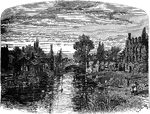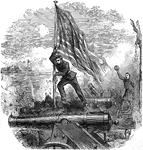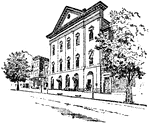The 1861-1865 Civil War Places ClipArt gallery offers 187 illustrations of places that are famous due to battles or other events during the American Civil War.
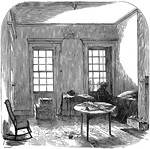
Major Anderson's Headquarters
The headquarters of Major Robert Anderson at Fort Sumter, South Carolina during the American Civil War.

Union Prisoners Confined at the Confederate Prison at Andersonville
Union soldiers being held at Andersonville, a Confederate prison.

United States Arsenal at Charleston
At the time this picture was drawn the handsome arsenal of the government of Charleston, South Carolina,…

Interior View of Fort Beauregard
Fort Beauregard, at Bay Point, on the point opposite Fort Walker, was built of sand and palmetto logs…

Belle Isle
"View of Richmond, Va., from the prison camp at Belle Isle, James River. Belle Island is situated in…

Bird's Point
"View of the fortifications erected by the Federal troops at Bird's Point, MO., opposite Cairo, Ill."—…

Bloody Angle of Spotsylvania
The angle between the Union II and VI Corps became known as the "Bloody Angle of Spotsylvania", where…

Drury's Bluff
"Drury's Bluff, a Confederate position on the James River, near Richmond, Va. The principal Confederate…

Bogue Island
"The Federal siege works on Bogue Island, N. C., erected for the reduction of Fort Macon. Our sketch…
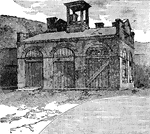
John Brown's Fort in Harpers Ferry
John Brown's Fort (the engine house) from John Brown's Raid on Harpers Ferry. Brown led a group of 21…
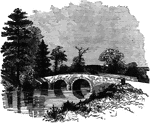
"Burnside Bridge," Antietam Creek
The bridge played a key role in the September 1862 Battle of Antietam during the American Civil War…

Buzzard's Roost
"Sherman's Campaign. The capture of Buzzard's Roost at Hovey Gap, Ga., May 8th, 1864. Among the strongholds…

Fort Calhoun
"Fort Calhoun, on the ripraps, situated between Fortress Monroe and Sewell's Point, in Hampton Roads,…

Camp Dennison
"Camp Dennison, sixteen miles above Cincinnati, on the banks of the Miami River, General Cox commanding-…

Camp Douglas
"Bird's-eye view of Camp Douglas, Chicago, Ill., used for the detention of Confederate prisoners in…

Camp Zagonyi
"Camp Zagonyi, encampment of Fremont's army on the prairie, near Wheatland, Mo., October 14th, 1861.…

Camp Zagonyi
"Camp Zagonyi, encampment of Fremont's army on the prairie, near Wheatland, Mo., October 14th, 1861.…
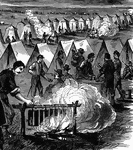
Camp Zagonyi
"Camp Zagonyi, encampment of Fremont's army on the prairie, near Wheatland, Mo., October 14th, 1861.…
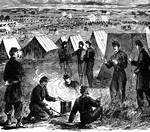
Camp Zagonyi
"Camp Zagonyi, encampment of Fremont's army on the prairie, near Wheatland, Mo., October 14th, 1861.…

Canton Road
"The war in Mississippi- General McPherson driving the enemy from their position on the Canton Road,…

Castle Thunder, Richmond, VA, Where Union Prisoners Were Confined
Castle Thunder, one of the Confederate prisons known for its abominable conditions.
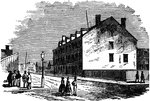
Castle Thunder
Castle Thunder, located in Richmond, Virginia, was a former tobacco warehouse located on Tobacco Row,…

Centreville
"View of the town of Centreville, Va., with the battlefield of Bull Run, Bull Run Mountains, Thoroughfare…

Ruins of Chancellorsville
The Battle of Chancellorsville was a major battle of the American Civil War, fought near the village…
Charleston Harbor
"The harbor of Charleston, S. C.- Fort Moultrie, on Sullivan's Island."— Frank Leslie, 1896
Advance upon Charleston
"The advance upon Charleston, S. C.- entrance to the Stono River."— Frank Leslie, 1896

Chattanooga, Tennessee in 1862
Chattanooga, "the Scenic City", is the fourth-largest city in Tennessee (after Memphis, Nashville, and…

Village of Clarksburg
"Village of Clarksburg, Western Virginia, headquarters of General Rosecrans. Clarksburg, a post village,…
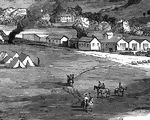
Village of Clarksburg
"Village of Clarksburg, Western Virginia, headquarters of General Rosecrans. Clarksburg, a post village,…
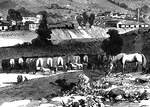
Village of Clarksburg
"Village of Clarksburg, Western Virginia, headquarters of General Rosecrans. Clarksburg, a post village,…
Fort Clinch
"Exterior view of Fort Clinch, on Amelia Island, Fla., commanding the Harbor of Fernandina, captured…
Fort Clinch
"Interior view of Fort Clinch, on Amelia Island, Fla., commanding the Harbor of Fernandina, captured…

Prison Pen at Columbia
"Appearance of the prison pen at Columbia, S. C., on the arrival of Sherman's army."— Frank Leslie,…

Columbus, Kentucky
"General view of Columbus, Ky., and its fortications, looking down the river, showing the 'Iron Bluffs'…
Commissariat Depot
"Commissariat Depot of the United States Army of the Rappahannock at Manassas, Va. Our sketch shows…
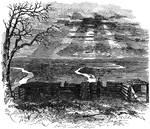
Confederate Battery on the Top of Lookout Mountain
The Battle of Chattanooga and included the Battle of Lookout Mountain on November 25, 1863 during the…

Confederate Fort
"Ruins of Confederate fort on the southeast side of Atlanta, with chevaux-de-frise and abatis in front."—…

Confederate Prison Camp
"The Confederate Prison camp at Belle Isle, James River, Va."— Frank Leslie, 1896
Culpepper Courthouse
"Culpepper Courthouse, or Fairfax, capital of Culpepper County, Va. This pretty little place, more frequently…

Cumberland Gap
"Cumberland Gap and Heights, Tenn., from the Kentucky side. Cumberland Gap was a place of such importance…

Edward's Ferry
"Edward's Ferry, Md., below Harrison's Island, on the Potomac River, the place of the passage of General…
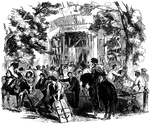
Adams Express
"Scene in Adams Express office, at Fortress Monroe, VA., in 1861- Volunteers receiving letters and packages…

Fair Oaks
The Battle of Seven Pines, also known as the Battle of Fair Oaks or Fair Oaks Station, took place on…
Falmouth
"The town of Falmouth, Va. on the Rappahannock, opposite Fredericksburg. Headquarters of General Burnside…

Federal Hill
"Federal Hill, Baltimore, taken from the North side basin, occupied by the Federal Troops."— Frank…

First Minnesota Regiment
"Fort built around the officer's quarters of the First Minnesota Regiment, Colonel Sully, near Fair…

Fort Donelson
Fort Donelson and Fort Heiman, two sites of the American Civil War Forts Henry and Donelson Campaign,…
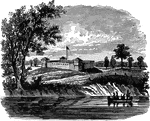
Fort Harrison, on the Wabash
Fort Harrison was an important component of the Confederate defenses of Richmond during the American…

Fort Hatteras
"General view of Forts Hatters and Clark, N. C., captured on the 29th of August, 1861, by the Federal…

Fort Jefferson, Garden Key
Fort Jefferson was built in 1826 in Garden Key, Florida and used in the American Civil War.


